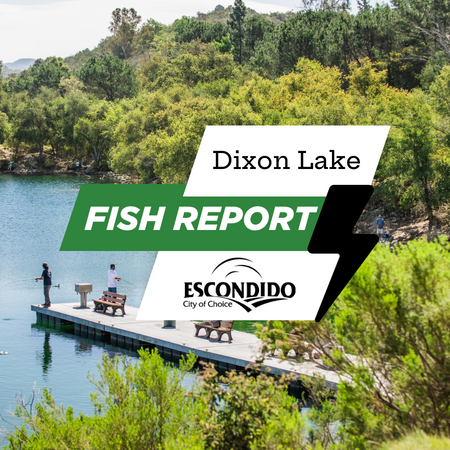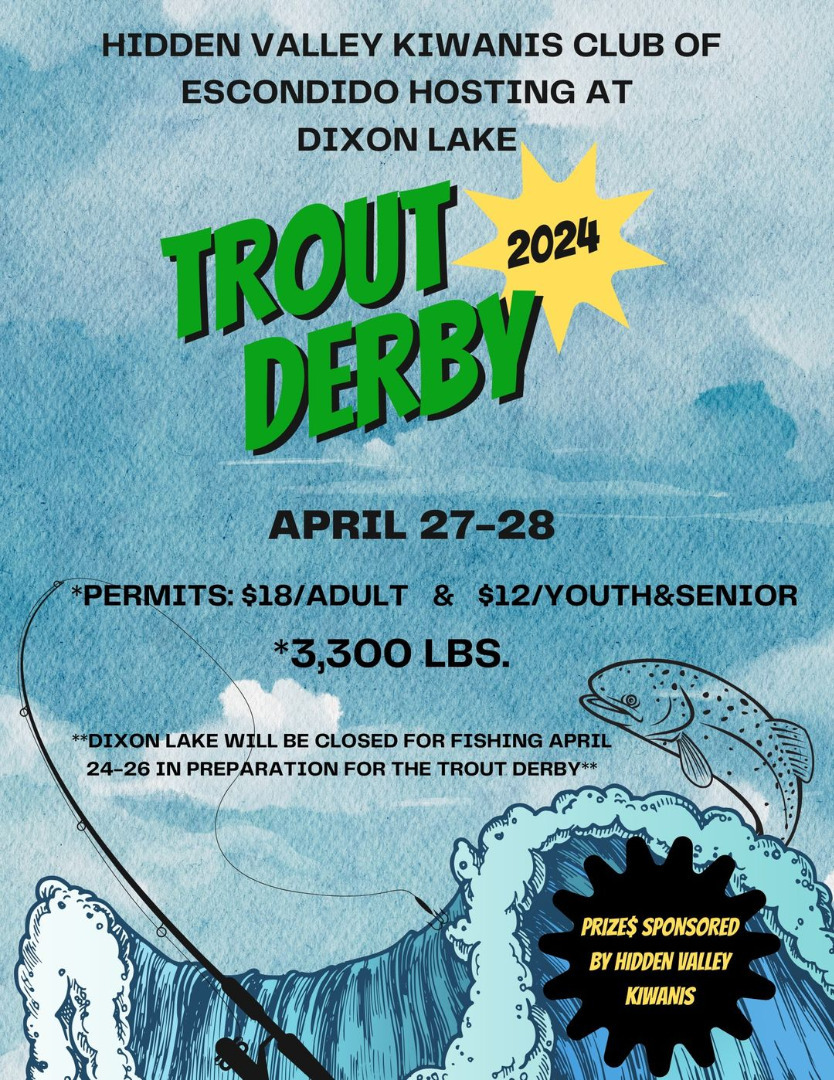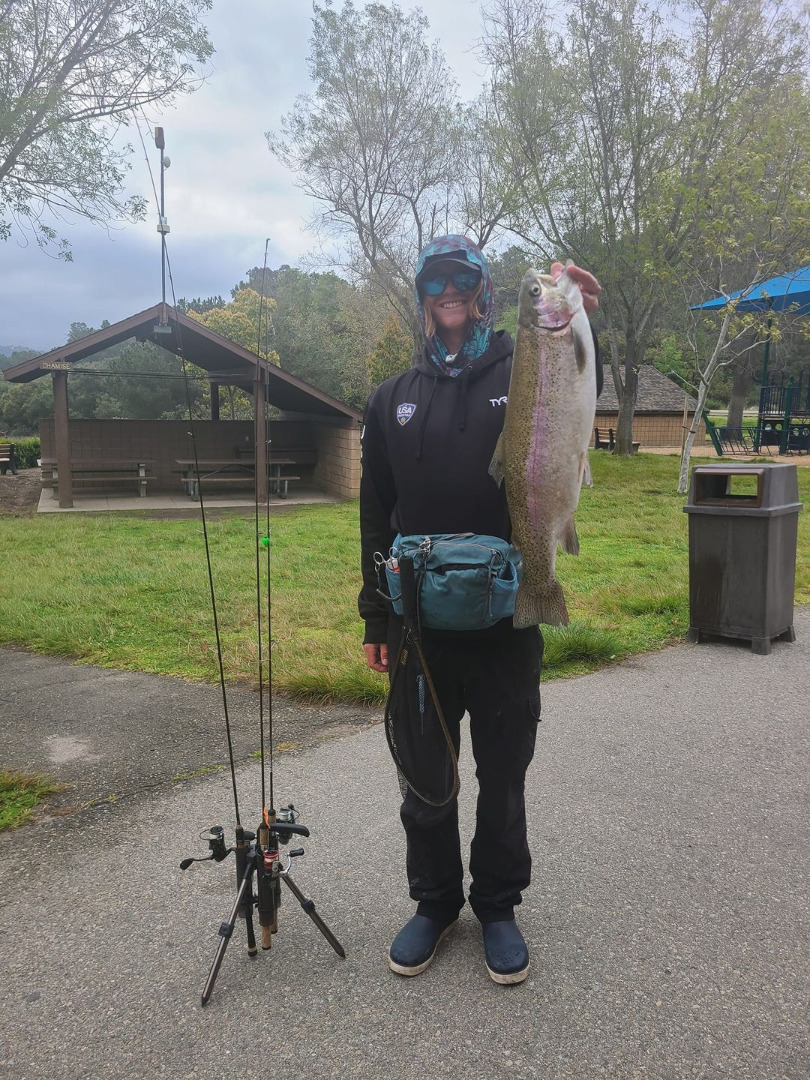From Sportfishing
Fish Report for 5-31-2024

Dixon Lake Fishing Report
5-31-2024
Dixon Lake Staff
Park hours: 6:00 A.M. – 8:00PM
Dock closes (boats called in): 6:30 P.M. Boats rentals end: 6:00 P.M.
Last Plant: Trout 3,300 lbs on Wednesday April 24th
Next Plant: Catfish in early July
Water temperature: At surface: 74.66°F
At 15 feet: 72.5°F
Dissolved Oxygen: At surface: 9.03 mg/L
At 15 feet: 9.32 mg/L
Water level: Moderate
Water Clarity: Good (14’)
CA state fishing licenses are not valid nor required at Dixon Lake but you must buy a Dixon Lake fishing permit at our concession stand. Single day permits are available for purchase at the Dixon Lake Concession Stand. Rangers strictly enforce the required fishing permits and fresh water regulations.
Pro Tip: If possible, come on weekdays for easier access to boat rentals and less crowded fishing spots.
Night fishing starts on July 12th.
There is a ban on private water craft and equipment. Restricted equipment includes: private boats of any kind, canoes, kayaks, float tubes, trolling motors, fish finders, anchors, and any other equipment that contacts the water. Swimming is also prohibited as the lake is used as a water source for the City of Escondido. Dogs must be on leash and at least 50 feet from the lake at all times.
Fishing permits, boat rentals, bait, and tackle are all sold at the Concessions Stand in the Lakeshore Area. Anglers "Must!" purchase a fishing permit before casting.
Normal Permit Pricing: ADULT PERMIT (16 years and older): $9 SENIOR PERMIT (60 years and over): $6 YOUTH PERMIT (8-15 years): $6 Child (under 8 years): FREE
If you desire to fish with a second pole, make sure to pick up a second rod permit for an additional $3.
Catfish: Catfish season is on the way, starting in early July. Due to the inherent cleanliness of Dixon Lake, the Catfish coming from our waters are quite tasty. Catfish are nocturnal scavengers, so the best time for them is either early morning or around sunset, however good bait and patience can snag you a couple at any time of the day. Catfish scavenge for food by detecting its scent in the water (their barbels [the whisker like appendages] are excellent in doing so), so any smelly bait works great on them! The stinkier the better! Many anglers have had success using cut up mackerel (especially dipped in hog’s blood), chicken liver, shrimp, and the classic nightcrawler. More offbeat, yet successful, bait has included hotdogs either soaked in Kool-Aid or by themselves. You might also try soaking your bait in garlic oil for a day or so prior to fishing. Catfish are a benthonic species (they live primary near the bottom), because of that, any rig setup that can get the bait near the lake bed is a good idea. Make sure to have decently heavy weights for your rig (a drop shot rig for catfish minimizes the risk of snags). Catfish Cove, Whisker Bay, and near the buoys (typically the middle of them) are our usual great spots to catch cats. Recently, Whisker Bay seems to be bringing about the most action. Reminder: Catfish are limited to 5 per permit!
Trout: Trout season has ended, with the last stocking having occurred on April 24th. That being said, anglers are continuing to pull some nice looking specimens. Whisker Bay maintains its standing as a hot spot for trout activity both on and after stocking days. This area can be easily accessed via short hike from the parking areas by Catfish Cove. If you rent a boat, anchoring by the buoy line (but not over) in front of the dam will likely net you some nibbles. When in a boat, please refrain from going past the smaller buoy lines by the coves. This could result in a revocation of boating privileges. Trout Cove also continues to be a solid bet, particularly in between stocking periods and if you desire more shade and solitude. Anglers swear by many differing trout catching methodologies, but it is generally recommended to use live bait (minnows, nightcrawlers, salmon eggs) with a slip bobber and a split-shot during the cooler months of year when trout are feeding in the upper portions of the water column. Switch to a bottom rig when water temperatures rise. Bucktail jigs can be effective when going for trout in deeper water. Power bait can also be an easily acquired go to. Try out different strategies and see what works for you. Reminder: Trout are limited to 5 per permit and cannot be released after being caught! Trout released after they are caught in this lake have very little chance of surviving.
Largemouth Bass: Piers 1 and 4, as well as the nearby shorelines, have been successful spots for catching Bass. Swimbaits are commonly used here for bass, Senkos and Roboworms are the usual, but any swimbait will do if you know how to work them properly. Color wise for swimbaits, purple continues to be a popular color this year, and I’ve been told once when you don’t know what color to throw, throw out something black. Topwater baits are also a fine choice, whether you use a rat or frog, you should see nice results using them. Dropshots and Texas rigs are excellent setups to use, Texas rigs especially if you’re fishing in the algae (do keep in mind that if you’re going to be casting into algae, having a heavier line will help reduce line breaks, you don’t want to lose that whopper on the other end! But our fish are as smart as our waters are clear, so if your line is too heavy, I don’t think you’ll fool the bass of Dixon.). Largemouth are ambush predators, meaning they like to hide in and around structures and heavily grown algae beds, waiting for a tasty snack to swim by before striking. While bass can be found anywhere in our lake, casting perpendicular to the edge of cover, whether it be any of the piers, near algae, or tules is always a good recommendation. Reminder: Bass are limited to 2 per permit, and must be at least 12 inches to keep!
Bluegill: Hot spots for bluegills are the dense algae beds (try to look for any open spots in said beds, it’s a great place to drop your line with a bobber attached), near and in the tules (reed-like vegetation growing in the shallow shores of the lake), around natural structures such as rocks or sunken trees and of course right beneath the piers. Bluegill fishing is a great way to teach newer anglers. Bluegill rigs are as simple as they come, have your hook on the bottom, some/a light weight(s) about a foot or so above, and a bobber starting off at about a foot away from the weight, keep in mind you’ll most likely will need to move the bobber up or down your depending on where the gills are at in the water column. While you can use small lures such as plastic minnows and small jigs, I always recommend either meal/red worms or cut up nightcrawler on about a size 6 hook. Bigger live baits/hooks can land bigger bluegills, just be careful, the small ones can and will take your bait leaving you with just a bare hook! Pier 1 is where most of our bluegill fishers go, it’s an easy walk with a lovely view of the lake, not to mention 3 benches there to laze away the day while waiting for that monster gill to come by. Reminder: Bluegills are limited to 25 per permit and cannot be used as bait!
For more information on park rules, future stocking schedules, and other information, please call the Dixon Lake Ranger station at 760-839-4680, or visit http://www.dixonlake.com. Dixon Lake can be found on Facebook at: http://www.facebook.com/dixonlakecitypark
< Previous Report Next Report >
More Reports
Trout Derby 2024
Dixon Lake
4-18-2024
The April Kiwanis Derby is approaching soon. Make sure to save the date. We look forward to seeing you out...... Read More
7lb Rainbow caught near Pier 1
Dixon Lake
4-5-2024
Maxwell with an awesome catch yesterday. 7lb Rainbow caught near Pier 1 on a gold spoon. ...... Read More

Website Hosting and Design provided by TECK.net